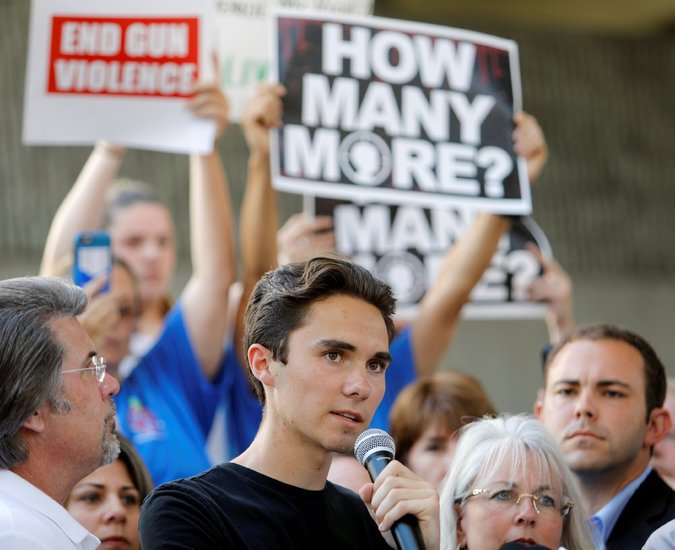“I had no idea where all the attention was coming from,” said “mike m.” in an online chat interview with The New York Times. “I just noticed it started to take off.”
Many commenters were confused. “Why is this on trending, especially on news? Nothing special,” wrote one. Others, tipped off by the caption calling Mr. Hogg an actor, knew exactly what they thought they were seeing: “Someone get this kid an Oscar!” one wrote.
By noon on Wednesday, YouTube had pulled the video for violating its policy on harassment and bullying.
It was not the first time that YouTube had served not just as a source of fringe conspiracy theories, but as an accomplice in their rapid spread.
After the massacre in Las Vegas last October, YouTubers filled a void of information about the killer’s motives with dark speculation, crowding the site with videos that were fonts of discredited and unproven information, including claims that the tragedy had been staged.
After a mass shooting last November at a church in Sutherland Springs, Tex., those seeking news about the event on YouTube were overwhelmed by videos falsely claiming it had been a “false flag” attack meant to spur gun control measures or a plot carried out by the so-called antifa (short for anti-fascist) movement.

In the wake of this latest tragedy, which left 17 people dead at the school in Parkland, YouTube still seemed caught by surprise by the rise of another video meant to peddle a baseless theory.
Advertisement
Continue reading the main story
“In 2017, we started rolling out changes to better surface authoritative news sources in search results, particularly around breaking news events,” YouTube, which is owned by Google, said in a statement. “We’ve seen improvements, but in some circumstances these changes are not working quickly enough. In addition, last year we updated the application of our harassment policy to include hoax videos that target the victims of these tragedies.”
Unlike the other unhinged clips that have garnered significant attention on YouTube in the recent past, the video of the Parkland survivor originated with neither a conspiracy-oriented media organization like Infowars nor one of the popular YouTubers who have catered to far-right subcultures and fringe political factions.
Newsletter Sign Up
Continue reading the main story
Thank you for subscribing.
An error has occurred. Please try again later.
You are already subscribed to this email.
Instead, it was posted to the infrequently updated account run by “mike m.” Up until the reposting of the video featuring Mr. Hogg, the account had fewer than a dozen videos and fewer than 1,000 followers. Although he declined to provide much information about himself or give his full name, “mike m.” said that he was a 51-year-old man living in Idaho.
His uploads included a handful of little-watched videos suggesting he is an avid fan of conspiracies. What inspired him to traffic in an unfounded theory about the Parkland shooting — aside from “having more time on my hands these days,” he said — were posts he had seen on the popular conspiracy site Godlike Productions. He pointed to comments on the site that claimed Mr. Hogg had been “coached” before giving interviews to members of the media who covered the massacre. It’s also where he found references to the beach video from last August.
Speaking to CNN on Tuesday, Mr. Hogg addressed the explosion of conspiracy theories head-on. “I’m not a crisis actor,” said Mr. Hogg, who had been visiting family and friends when he appeared in the Los Angeles news segment. “I’m someone who had to witness this and live through this and I continue to be having to do that. I’m not acting on anybody’s behalf.”
The video posted by “mike m.” rapidly gained steam nonetheless.
What propelled this one to popularity — and eventually into YouTube’s promotional apparatus — came from outside the platform.
Links to the video proliferated on 4chan, where users have gleefully embraced the conspiracy theories and mocked the shooting victims. When it hit YouTube’s Trending page, some on 4chan celebrated: “TRENDING IN THE USA,” began one thread in the far-right politics board called /pol/. “WE’RE BREAKING THE CONDITIONING.”
The “mike m.” video also found traction on Twitter, on Facebook and in stories and comment threads on conspiracy sites. It rose in the circuitous and unexpected manner of a viral video, rather than one that had been calculated to game YouTube’s algorithms by seizing on interest in breaking news or tragedy — it had no catchy headline, no recognizable personality, no vast theorizing. And yet it blasted through YouTube’s safeguards and somehow kept going, exposing the platform as vulnerable to sudden influence from inside and outside its walls.
After YouTube removed the video, “mike m.” said his account had received a “strike” — that is how YouTube warns users that they have broken the site’s rules or violated its guidelines. (Three strikes and you’re out.) “I mean, why strike me over a beach confrontation video???” he said. A second video he had posted about the shooting was gaining popularity Wednesday morning, he said, until it, too, was deleted, and another strike was added to his account.
Anonymous and remorseless, “mike m” was undeterred. “There is more to this kid than appears on MSM,” he said, using the common shorthand for “mainstream media.” Asked if he would think twice about posting such videos in the future, he said, “No not at all.”
Advertisement
Continue reading the main story
He said he was worried about his account getting deleted, adding: “But I am not going to stop.”
Continue reading the main story
Article source: https://www.nytimes.com/2018/02/21/business/media/youtube-conspiracy-video-parkland.html?partner=rss&emc=rss
Speak Your Mind
You must be logged in to post a comment.